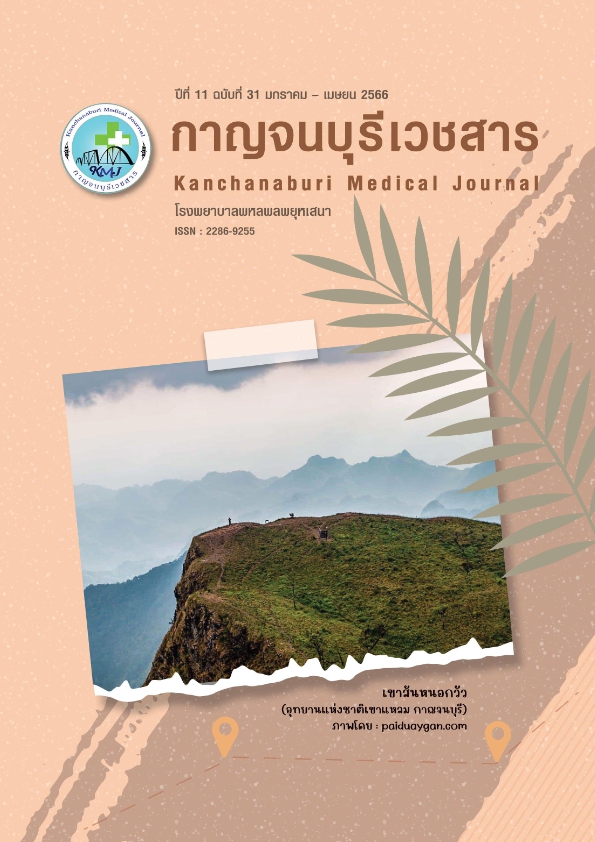Clinical manifestation of patients who infected with Plasmodium Vivaxmalaria
Abstract
Malaria is a protozoan infection transmitted to humans by Anopheles mosquito. P. Vivax is most common malaria in Thailand. This study is to demonstrate clinical characteristics and treatment results of P. Vivax in Kanchanaburi province.
Results, there is equal number of male and female patients. Most of them did not have underlying diseases. They relatively came in with low blood pressure. Most common symptoms were fever (97.70%), shortness of breath (33.30%), and headache (25.60%). In addition, other symptoms may occur slightly, such as muscle pain and jaundice. Consistent with the results of laboratory tests, which found to have a slight increase in Total Bilirubin (1.90 ± 1.60 u/mL), a slight increase in Direct Bilirubin (0.80 ± 0.90 u/mL) and a mean increase in blood sugar of 178.3 ± 12.56 mg/mL. Red blood cells were found in the urine. But complete blood count (CBC) and liver function (LFT) were all within normal limits.
According to a study of P.vivax-infected patients in Kanchanaburi province, 51.16% had complications, (66 out of 129 cases). 52 (40.30%) had low blood pressure. 18 (14%) had anemia.For severe complications, 11 (8.5%) had respiratory failure. 12 (9.30%) had metabolic acidosis, and 1 death (0.8%) from muti-organ failure. All patients received the standard treatment of chloroquine together with primaquine. The treatment results in this study had 99.20% cure
In conclusion, Kanchanaburi has good standard treatment and care according to WHO guidelines. Even though, recommendation to prevention P. Vivax infection is the prevention measures against mosquito bite such as avoid travel in mosquito area, repellent and insecticide.
References
กรมควบคุมโรค แ. แนวทางเวชปฏิบัติในการรักษาผู้ป่วยโรคไข้มาลาเรีย กรุงเทพฯ: กองโรคติดต่อนำโดยแมลง กรมควบคุมโรค กระทรวงสาธารณสุข; 2562.
Baird JK, Valecha , Duparc , White , Price. Diagnosis and Treatment of Plasmodium vivax Malaria. Am. J. Trop. Med. Hyg. 2016;: p. 35-51.
Howes , Smith DL, Mendis , Battle , Cibulskis , Baird JK, et al. Global Epidemiology of Plasmodium vivax. Am. J. Trop. Med. Hyg. 2016;: p. 15-34.
World Health Organization. (2021). Malaria. Retrieved from: https://www.who.int/news-room/fact-sheets/detail/malaria.
Centers for Disease Control and Prevention. (2021). Malaria. Retrieved from https://www.cdc.gov/malaria/index.html.
World Health Organization. (2019). World malaria report 2019. Retrieved from:
https://www.who.int/publications/i/item/9789241565721.
White, N. J., &Pukrittayakamee, S. (2014). Malaria. The Lancet, 383(9918), 723-735.
Murray, C. J., Ortblad, K. F., Guinovart, C., Lim, S. S., Wolock, T. M., Roberts, D. A., ... & Lopez, A. D. (2014). Global, regional, and national incidence and mortality for HIV, tuberculosis, and malaria during 1990-2013: a systematic analysis for the Global Burden of Disease Study2013. The Lancet, 384(9947), 1005-1070.
World Health Organization. (2020). Malaria vaccine implementation programmed (MVIP). Retrieved from:
https://www.who.int/initiatives/malaria-vaccine-implementation-programme.
Nosten, F., White, N. J., & Artemisinin Resistance in Malaria Consortium. (2016). Artemisinin resistance in malaria. New England Journal of Medicine, 375(25), 2457-2460.
Downloads
Published
How to Cite
Issue
Section
License
Copyright (c) 2023 Phaholpolpayuhasena Hospital

This work is licensed under a Creative Commons Attribution-NonCommercial-NoDerivatives 4.0 International License.
บทความที่ได้รับการตีพิมพ์เป็นลิขสิทธิ์ของโรงพยาบาลพหลพลพยุหเสนา
ข้อความที่ปรากฏในบทความแต่ละเรื่องในวารสารวิชาการเล่มนี้เป็นความคิดเห็นส่วนตัวของผู้เขียนแต่ละท่านไม่เกี่ยวข้องกับโรงพยาบาลพหลพลพยุหเสนาและบุคลากรท่านอื่น ๆ ในโรงพยาบาลฯ แต่อย่างใด ความรับผิดชอบองค์ประกอบทั้งหมดของบทความแต่ละเรื่องเป็นของผู้เขียนแต่ละท่าน หากมีความผิดพลาดใด ๆ ผู้เขียนแต่ละท่านจะรับผิดชอบบทความของตนเอง



 Phaholpolpayuhasena Hospital
Phaholpolpayuhasena Hospital
